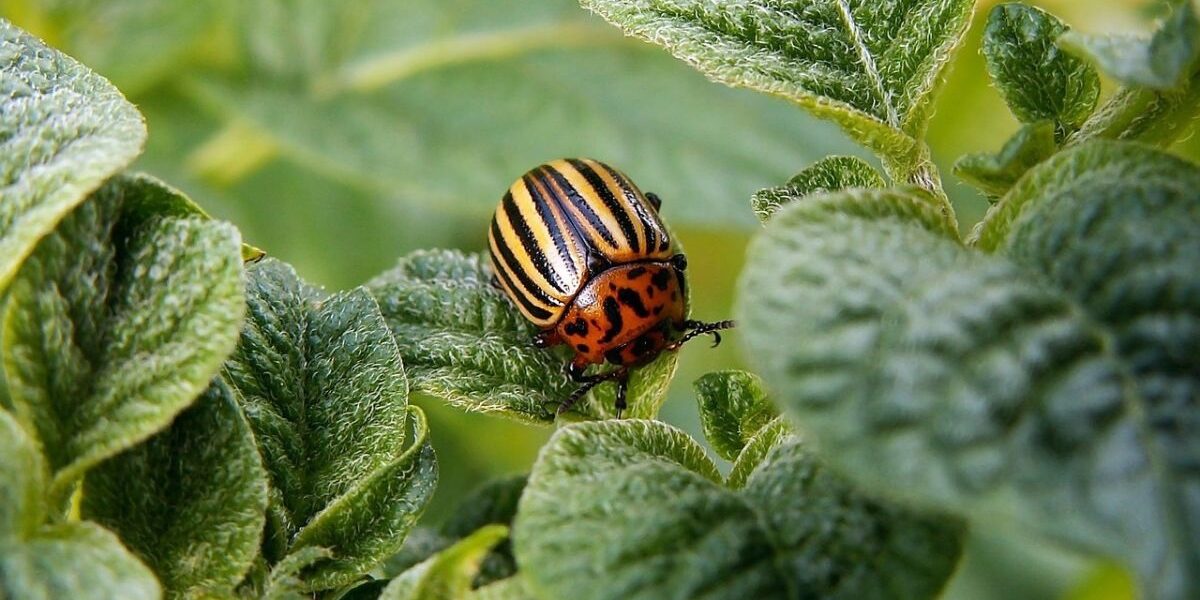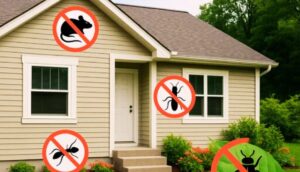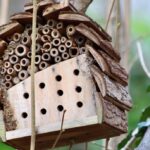How to Get Rid of Colorado Potato Beetles
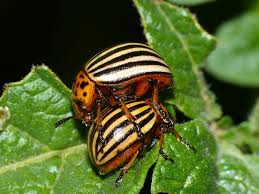
Colorado potato beetles, which belong to the family Chrysomelidae or leaf beetles, are a common pest problem in home gardens and crops. The host plants most susceptible to these beetles are potatoes, peppers, tomatoes, and nightshade.
With 35,000 species worldwide, it is the third largest family in the order Coleoptera. Both the adult and the larvae consume the same plant species. If you have come across these beetles in your home garden, especially with an infestation, here are proven methods for managing their population.
Colorado Potato Beetle Identification
The adult Colorado beetle has an oval shape, 3/8 inch long, a yellow to orange prothorax, which is the area behind their head, with yellowish to white wings. covers with 10 narrow black stripes that are noticeable. Young larvae are brick red with blackheads. As the larvae mature, their color changes from pink to salmon, but the color of their head remains black. All Larvae possess two rows of dark spots on either side of their bodies.
Colorado Potato Beetle Life Cycle
After mating, the female lays about 10-30 eggs in clusters on the undersides of leaves, depending on the temperature. After eggs are laid will take about two weeks as they begin to hatch. Once hatched, the larvae begin to feed immediately. The larvae go through four stages in two to three weeks. Soon, the larvae enter the soil, forming a spherical cell and pupate. The new adults emerge in five to ten days, and the life cycle is repeated through a second generation.
Colorado Potato Beetle Damage
Signs of Colorado potato beetle damage include notch wounds along the leaf margin, ragged injuries, and dark frass on the foliage. These beetles can completely defoliate the host plant; in some cases, the stems and even the potato tubers may be gnawed.
How to Control Colorado Potato Beetles
There are several methods to manage the Colorado beetles, and control methods may vary depending on the extent of the damage. For example, if there is a serious outbreak or infestation, Insecticides may be needed vs using only mechanical control methods.
Cultural Practice to Control Colorado Potato Beetles
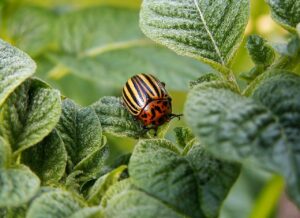
Cultural practices will help reduce the Colorado potato beetle’s natural habitat.
- Put a garden maintenance program in place to clean up debris and rake up leaves regularly.
- The installation of cover crops around your garden to attract beneficial insects is a biological method that will help to control the Colorado potato beetle population.
- Hand-picking the adult Colorado potato beetle and throwing them into a container of soapy water will kill them. Wearing garden gloves should be something to consider before attempting to hand-pick beetles.
- Check seed catalogs for varieties that mature in less than 80 days.
- Plants that produce pollen should also be planted around your garden to encourage the presence of beneficial insects to control Colorado potato beetles.
- Because the larvae enter the soil to complete their lifecycle, adding a 2-3 inch layer of mulch to garden plants will make it difficult for the larvae to accomplish this, which can lead to their elimination.
- Make sure that your plants are growing healthy because healthy plants are better able to withstand feeding injuries and may recover quickly.
- Crop rotation has proven to be effective.
- Plant an early-maturing variety to avoid much damage caused by adults that emerge in midsummer.
- To make it difficult for adults to overwinter, make sure that your garden plant beds are thoroughly cleaned at the end of the year.
Mechanical Control of Colorado Potato Beetles
- Mechanical control involves the same method as cultural practices, which involves hand-picking the potato beetles and throwing them into a bucket of soapy water that will eliminate them.
- In late fall, till the soil to expose overwintering bugs.
Controlling Colorado Potato Beetles with Insecticides
- The larval stage of the Colorado potato beetle can be controlled with an organic product such as spinosad. Once applied, spinosad is effective for about 10-14 days.
- Neem products can also be used to achieve the same results. The neem application lasts a few days shorter than spinosad.
- Rotation of insecticides is important to safeguard insects from becoming resistant.
Both Spinosad and Neem are effective in controlling the larval stages of the Colorado potato beetle. Before the application of insecticides, read and follow the manufacturer’s directions on the label for the best results.
Monitoring Colorado Potato Beetles
Because the adult beetles are active during springtime, it’s important to monitor your crops for these beetles and put a plan in place immediately to bring control.
- Begin a scouting program by going into your garden and doing a weekly inspection, or inspecting every few ( 3-4) days.
- Examine the foliage (leaves), stalks, and stems for both the larvae and the adult beetle. The eggs are laid in clusters, are yellow to orange, and are about 1 mm (0.039 in) long. The eggs are laid on the underside of leaves.
- To spot the larvae, easily look towards the tops of the plants because this is where feeding takes place.
- If the number of beetles and larvae is great, along with damage, treat immediately with an insecticide.
Conclusion
Colorado potato beetles can become a big deal if left and allowed to grow into an infestation, but as much devastation as these beetles cause, control measures and managing them is possible by following the proven steps in this guide. Why allow this beetle to rob you of your harvest when you can strike back, bringing an end to their destructive behavior?

